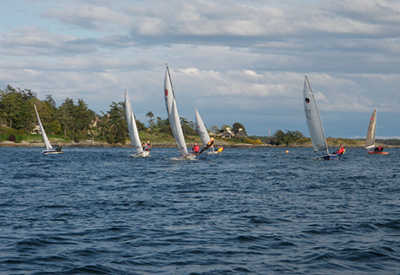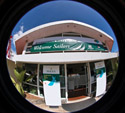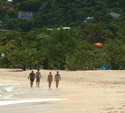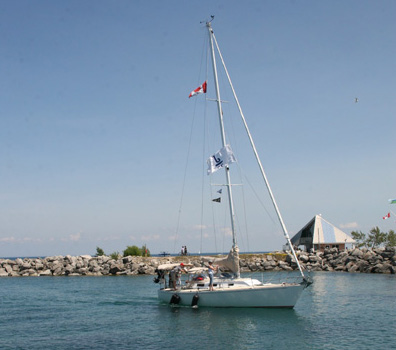A Trent-Severn Mini-Loop Adventure
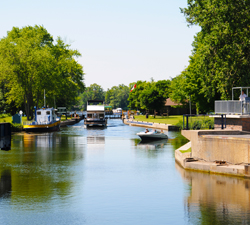
A Trent-Severn Mini-Loop Adventure
By Maurice and Helene Marwood and Terry and Linda Hilts
It was still dark when we departed our home slips in Chrystal Harbour, LaSalle, Ontario, and entered the Detroit River. It was August 2nd, 2013, the first day of our adventure to complete the mini-loop counterclockwise from LaSalle, down Lake Erie and Lake Ontario, through the Trent-Severn Waterway, across Georgian Bay, down Lake Huron and back home to LaSalle.
Maurice and his wife, Hélène, traveled on Mystic Blue, a Mainship 30 Pilot Classic. Terry and his wife, Linda, voyaged on their Camano Troll, 4 Buoys. Both vessels were designed to cruise at a comfortable and economical speed of about 10 to 12 knots. At that speed we knew it would be a long day to reach our first stop at Erieau. Fortunately, the water on Lake Erie was exceptionally flat and, as a bonus, we enjoyed a light westerly wind on the stern. Our schedule allowed about a month to complete the entire loop, and we knew the journey included relatively long stretches of open water, so we hoped the good weather window would continue.
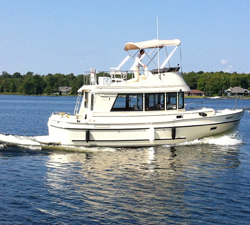 The first minor mishap occurred on 4 Buoys within two hours of leaving port. Two inches of water was suddenly discovered on the galley floor as a result of forgetting to close the port hole in the V-berth. The warm sunny weather aided the drying-out process and there were no detrimental consequences. As it turned out, that minor event was the only mishap during the entire trip.
The first minor mishap occurred on 4 Buoys within two hours of leaving port. Two inches of water was suddenly discovered on the galley floor as a result of forgetting to close the port hole in the V-berth. The warm sunny weather aided the drying-out process and there were no detrimental consequences. As it turned out, that minor event was the only mishap during the entire trip.
At noon on the fourth day we arrived at the entrance to the Welland Canal. This man-made Canal was originally completed in 1830 to allow ships to bypass Niagara Falls. The Welland Canal can be a challenge; however, we enjoyed an easy transit in good weather descending the 99 meters through eight locks from Lake Erie to Lake Ontario. Nevertheless, the 43 km trip required serious concentration, so by the end of the day we were emotionally exhausted and ready to stop for the night at the pleasure craft dock on the Canal at Port Weller, near the entrance to Lake Ontario.
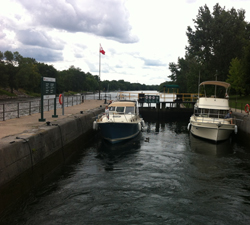
The next day we decided to set a course on a straight line diagonally across Lake Ontario to Cobourg. The water was exceptionally flat, the sun shone and the wind was on the stern—resulting in a very relaxing crossing. The weather continued to hold and after two more long days we arrived at the Murray Canal and tied up for the night at the Brighton Road Swing Bridge. The Murray Canal is a narrow man-made canal 5 miles long that connects the Bay of Quinte to Lake Ontario. The next day we finally arrived at Trenton on schedule, and spent a restless night at Fraser Park Marina, excited and anxious to enter the Waterway.
The next morning, with great anticipation, we passed under the bridge that marks the entrance to the Waterway and traveled a short distance to the first lock. Although we had already experienced the locks on the Welland Canal, the 44 locks on the Waterway were a complete unknown to us and as casual boaters, we had not dealt with the intricacies of “locking” during our normal cruising season. After navigating a couple of locks on the Waterway, the procedure became quite routine — with the exception of a couple of tense moments when the cross-winds briefly took control and we had to make a second effort to get attached to the lock wall. The lock attendants were very patient and helpful. It is important to know the rules and follow the rules.
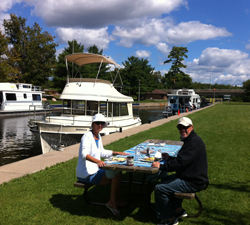
By the end of the first day we had transited six locks, and decided to spend the night tied alongside the lock wall at Frankford. Most of the lock walls provided a pleasant place to moor for the night adjacent to park areas, picnic tables, BBQs, and washrooms. Subsequently, we enjoyed many nights alongside the lock walls, and found them to be quiet, safe and convenient.
Often the locks were adjacent to small communities where we visited a few of the local highlights, and replenished our fresh food supply at the local grocery stores. Occasionally we enjoyed the fare at the local restaurants nearby. A highlight was dinner at Hot Belly Mama’s in Peterborough. The New Orleans’ ambiance, the music, the food and the décor made it a unique experience. Not surprisingly, it attracts visitors from all over the world.
The first series of locks were quite close together and after a long and tiring third day, we had already transited 18 locks and for a change of pace, we decided to anchor for the night in the Trent River near Hastings.
After a few days, we had established something of a routine. Most mornings we were up and on our way in time to catch the first lock opening at 9 am. By mid-afternoon we usually stopped for the day, which gave us time to wind down, take a swim and enjoy happy-hour before preparing the evening meal. When the weather was pleasant, we usually ate picnic-style outdoors on the deck of our boats, or at the park benches nearby. On days when it was a bit cool or windy, we ate in the protection of 4 Buoys’ comfortable enclosed salon. The first mates’ talents in the small galleys repeatedly surprised and spoiled the skippers with simple, but substantial gourmet meals.
 It was with some trepidation that we came around the bend and cautiously approached the hydraulic lift lock near Peterborough. Completed in 1904, the technology is still impressive today. It is the highest hydraulic dual-lift lock in the world and is designated a National Historic Site and a Historic Mechanical Engineering Landmark. The top chamber moves down simply by allowing more water into the chamber. As the heavier top chamber moves down, the other moves up. No external energy is required; it’s like a perpetual motion machine.
It was with some trepidation that we came around the bend and cautiously approached the hydraulic lift lock near Peterborough. Completed in 1904, the technology is still impressive today. It is the highest hydraulic dual-lift lock in the world and is designated a National Historic Site and a Historic Mechanical Engineering Landmark. The top chamber moves down simply by allowing more water into the chamber. As the heavier top chamber moves down, the other moves up. No external energy is required; it’s like a perpetual motion machine.
We had read about the lock, but did not know what to expect. Fortunately, there were few boats waiting to enter so we were able to enter the up-bound chamber quickly and easily. It only took about 2 minutes to rise 65 feet, allowing us to continue on our journey. For a few moments, we enjoyed a beautiful panoramic view of the surrounding countryside from the top of the lock. Reportedly, it is not unusual for 25 to 30 boats to transit in a single day.
There is much history along the Waterway, and if you make the journey, take time to explore what the region has to offer. We would recommend a visit to the Canadian Canoe Museum in Peterborough. It is much more than a display of ancient canoes. The museum includes interactive exhibits, and illustrates the historical character and spirit of the early pioneers. It is well worth the short walk.
The guidebooks and websites provide many options and recommendations for exploring. Our two-week time limitation prevented us from fully enjoying what the area has to offer. If you go, allow as much time as you can because there is much to explore and investigate.
On day-15, we arrived at Bobcaygeon, a small village that sits at the site of the first lock constructed on the Waterway, lock #32. It is also the site of the oldest swing bridge in operation. We strolled through its quaint downtown area and enjoyed a savory coffee and pastry at Savoury’s Café. Bobcaygeon is considered the hub of the Kawartha Lakes region and is a dream destination for outdoor enthusiasts with pristine waterways and some of the best fishing in Ontario.
Occasionally, we took advantage of opportunities to anchor instead of mooring alongside the lock walls. Anchoring is the ideal way to enjoy the beauty, peace and silence of nature. There are numerous secluded and well-protected anchorages in the lakes and rivers along the route, and many are identified on the charts. We would particularly recommend Buckhorn Lake, Clear Lake, Balsam Lake and Sparrow Lake. In each case, the water was warm and clear, and anchoring made it particularly easy to take a refreshing swim, which we did at every opportunity.
A major highlight of the trip was the constantly changing scenery. One day might be spent at a dead slow no-wake speed within a few meters of the cottages along the shore; the next might be crossing a secluded lake with stunning natural beauty of heavily-wooded islands with rocky outcroppings scattered haphazardly along the rivers and lakes.
One unique characteristic of the Waterway is its summit. From Trenton to Kirkfield (km 273), 35 locks raised us about 600 feet. Then from Kirkfield, the remaining 9 locks lowered us about 260 feet to Port Severn on Georgian Bay. From Trenton to Kirkfield, the red buoys had been on the right, since we were going up stream. Then, from Kirkfield to Port Severn we took careful note that the red buoys were now on the left since we were going down stream.
There were numerous times when it was necessary to carefully concentrate on the buoys marking the route to avoid hazards lurking just below the surface. Although the route was well marked and relatively easy to navigate, it is critical to know where you are and where you are going. The GPS Chartplotter was indispensable, but it was also necessary to cross-reference the paper charts. Also, an autopilot is recommended to help hold a straight course, but be sure to maintain a constant lookout.
Kirkfield is the second highest hydraulic dual-lift lock, quite similar to the one at Peterborough. There are only 9 hydraulic lift locks and the other 7 are in England, France and Belgium. We knew what to expect when we approached the Kirkfield lift lock and the transit was quick, smooth and relaxing.
We did not spend time touring Lake Simcoe because we preferred to spend our time in the secluded Kawartha Lakes region. The name “Kawartha” means “land of shining waters” in the language of the First Nations’ Peoples. You will understand as soon as you see the sun dancing off the shining ripples of the lakes and rivers.
Slowly we watched the environment change from charming communities and the panoramic beauty of the scenic farmland to pristine wilderness of evergreen trees clinging to the rocky outcroppings of the Canadian Shield. We never got bored with the beauty of the region.
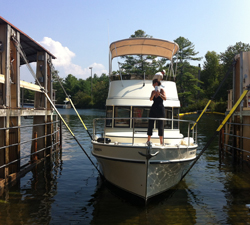 The second last lock on the system was the Big Chute Marine Railway. As far back as 1914, plans were made to construct conventional locks to connect the Waterway to Georgian Bay at Port Severn, Big Chute and Swift Rapids. For a variety of reasons, the plans were postponed and “temporary” marine railways were built instead. Over the years, the railway became permanent and enlarged to handle commercial vessels. Since there is no water transfer across the lock, it blocks the migration of invasive species into Lake Couchiching and Lake Simcoe. In the 1960s, this was a major concern because the Sea Lamprey was harming the fishing industry in the Great Lakes.
The second last lock on the system was the Big Chute Marine Railway. As far back as 1914, plans were made to construct conventional locks to connect the Waterway to Georgian Bay at Port Severn, Big Chute and Swift Rapids. For a variety of reasons, the plans were postponed and “temporary” marine railways were built instead. Over the years, the railway became permanent and enlarged to handle commercial vessels. Since there is no water transfer across the lock, it blocks the migration of invasive species into Lake Couchiching and Lake Simcoe. In the 1960s, this was a major concern because the Sea Lamprey was harming the fishing industry in the Great Lakes.
We slowly floated into a cradle that lifted us out of the water. The boat rested on the bottom of the cradle while slings provided support to prevent tipping as the carriage slowly followed dual tracks on an inclined slope to the water about 60 feet below. The Railway was exhilarating; certainly a unique locking experience.
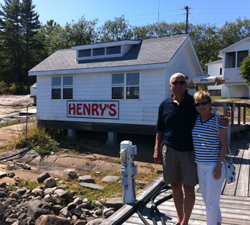 The next day, on schedule, we arrived at Georgian Bay and celebrated the completion of a successful transit of the entire Waterway. The weather continued to hold as we made our way up the Thirty-Thousand Islands to Honey Harbour and Parry Sound with a lunch stop at Henry’s famous fish restaurant on Frying Pan Island in the Sans Souci area. As we enjoyed Henry’s famous pan-fried fresh Pickerel, sea planes flew in and out shuttling tourists and cottagers from Parry Sound and Midland.
The next day, on schedule, we arrived at Georgian Bay and celebrated the completion of a successful transit of the entire Waterway. The weather continued to hold as we made our way up the Thirty-Thousand Islands to Honey Harbour and Parry Sound with a lunch stop at Henry’s famous fish restaurant on Frying Pan Island in the Sans Souci area. As we enjoyed Henry’s famous pan-fried fresh Pickerel, sea planes flew in and out shuttling tourists and cottagers from Parry Sound and Midland.
The brief exposure to the beauty of Georgian Bay cemented the decision to come back and explore more, but for now, it had to wait. Our attention was focused on getting across to Tobermory, down Lake Huron and home. The long-standing reputation of the rough waters on Georgian Bay and Lake Huron certainly gave us some concern and sure enough, after three weeks of sunshine, dark clouds rolled in with rain and high winds from the west on the very day we intended to make the crossing.
On our first attempt, we met steep and breaking two-meter waves; we had to turn back. The next day was the same, so we spent two days waiting out the storm near Snug Harbour. Fortunately, the storm quickly passed and on the morning of the third day, the sky was clear, the wind light and the Bay calm. We headed out early and enjoyed a very smooth crossing to Tobermory where we spent the night, much relieved, at the Government Dock. The weather remained pleasant as we hopped and skipped down the coast of the Bruce Peninsula, stopping at Port Elgin, Bayfield, and Sarnia. Time allowed a brief unscheduled stop at the Algonac Harbour Club on the St. Clair River, and at the Jefferson Beach Marina at St. Clair Shores. Finally, we arrived home in LaSalle after 32 wonderful days on the water and checked a big item off the “bucket list.”
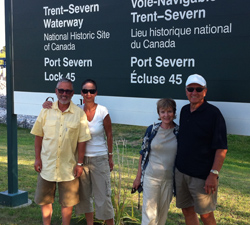 Cruising can be a joyful highlight of your life’s voyage. The time and effort to plan and prepare is not only worth it, it is part of the adventure. Prepare carefully, take small steps, set a steady course and then throw off the dock lines that bind you to the shore. It is our hope that you put the Trent-Severn Waterway on your list of destinations. It will be a cruising delight and a magnificent adventure of a lifetime. The entire Trent-Severn Waterway is a Canadian National Historic Site, and is certainly worthy of the designation.
Cruising can be a joyful highlight of your life’s voyage. The time and effort to plan and prepare is not only worth it, it is part of the adventure. Prepare carefully, take small steps, set a steady course and then throw off the dock lines that bind you to the shore. It is our hope that you put the Trent-Severn Waterway on your list of destinations. It will be a cruising delight and a magnificent adventure of a lifetime. The entire Trent-Severn Waterway is a Canadian National Historic Site, and is certainly worthy of the designation.
Statistics
Elapsed Time 32 days
Distance Traveled 957 km
Engine Hours 126
Average Speed 5.5 knots
Avg. Fuel Consumption 14.6 liters/hr.
Photo 1: Lock 20 is typically “Trent Severn” scenery with lush trees and clear waters.
Photo 2: 4Buoys embarking on the trip and cruising comfortably on Lake Ontario on a fine day in wonderful flat water.
Photo 3: Plenty of room for vessels side by side in the locks.
Photo 4: Enjoying an outdoor picnic-style dinner alongside the Waterway.
Photo 5: A view from the top of the highest hydraulic lift lock in the world at Peterborough.
Photo 6: 4Buoys going through the Big Chut Marine Railway—Lock 44; km 374; Lift: 57 ft.
Photo 7: A memorable stop at the famous Henry’s Fish Restaurant on Frying Pan Island, Georgian Bay.
Photo 8: Happy to have completed 386 km through the entire Waterway.


